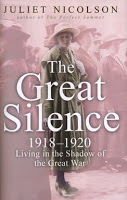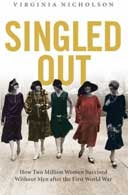 The Great Silence: 1918-1920, living in the shadow of the Great War by Juliet Nicolson is a social history which casts a light on the two years following the armistice, from the time the guns went silent to the internment of the Unknown Soldier in Westminster Abbey in November 1920. Great Britain was a nation suffering from post-traumatic stress. There was collective mourning for the generation of lost young men.
The Great Silence: 1918-1920, living in the shadow of the Great War by Juliet Nicolson is a social history which casts a light on the two years following the armistice, from the time the guns went silent to the internment of the Unknown Soldier in Westminster Abbey in November 1920. Great Britain was a nation suffering from post-traumatic stress. There was collective mourning for the generation of lost young men.
Following the ceasefire and the silencing of the guns, rather than the expected relief and optimism, people faced an uncertain world in which so much had changed. Soldiers returned to find themselves unemployed and often unemployable. There was industrial unrest as the working classes grew frustrated with their circumstances. There was a housing crisis. Women’s roles changed as they obtained the vote and a greater scope of employment opportunities. The British monarchy faced a uncertain future as other European monarchies collapsed around them.
Nicolson has written a highly readable, engaging story that is as entertaining as a novel. The chapters are named with emotionally charged one word labels ( Anger, Hopelessness, Dreaming, Hope) which have a Kubler-Ross feel to them. The portraits and vignettes are drawn from diaries, letters and personal recollections of the royalty, aristocracy, intellectuals, politicians and ordinary people. The result is impressionistic rather the conclusive.
She writes, quite feelingly, of the wounded soldiers. They received pensions according to the limbs affected. So much for an arm, so much for a leg, but nothing for damage inflicted about the neck. Apparently the government didn’t see the loss of half a face as being an impediment to employment. Interesting advancements were made with skin grafts and plastic surgery. Psychiatry was in its early stages and shell shocked soldiers were treated with electric shocks and demands for them to be strong and be examples. Those lucky enough to survive often dreamt of returning to a wife, kiddies and home, however, the reality was often different.
For other views of this most interesting time in 20th century history try:
Singled Out: how two million women survived without men after the First World War by Virginia Nicholson – “Drawing upon a wealth of moving memoirs, Singled Out tells the inspiring stories of these women: the student weeping for a lost world as the Armistice bells pealed, the socialite who dedicated her life to resurrecting the ancient past after her soldier love was killed, the Bradford mill girl whose campaign to better the lot of the “War spinsters” was to make her a public figure–and many others who, deprived of their traditional roles, reinvented themselves into something better. Tracing their fates, Nicholson shows that these women did indeed harbor secret sadness, and many of them yearned for the comforts forever denied them–physical intimacy, the closeness of a loving relationship, and children. Some just endured, but others challenged the conventions, fought the system, and found fulfillment outside of marriage. From the mill-girl turned activist to the debutante turned archaeologist, from the first woman stockbroker to the “business girls” and the Miss Jean Brodies, this book memorializes a generation of young women who were forced, by four of the bloodiest years in human history, to stop depending on men for their income, their identity, and their future happiness. Indeed, Singled Out pays homage to this remarkable generation of women who, changed by war, in turn would change society.” – publisher
 Bright Young People: the lost generation of London’s jazz age by D.J. Taylor – “The modern obsession with celebrity began with the Bright Young People, a voraciously pleasure-seeking band of bohemian party-givers and blue-blooded socialites who romped through the gossip columns of 1920s London. Drawing on the virtuosic and often wrenching writings of the Bright Young People themselves, the biographer and novelist D. J. Taylor has produced an enthralling account of an age of fleeting brilliance.” – publisher
Bright Young People: the lost generation of London’s jazz age by D.J. Taylor – “The modern obsession with celebrity began with the Bright Young People, a voraciously pleasure-seeking band of bohemian party-givers and blue-blooded socialites who romped through the gossip columns of 1920s London. Drawing on the virtuosic and often wrenching writings of the Bright Young People themselves, the biographer and novelist D. J. Taylor has produced an enthralling account of an age of fleeting brilliance.” – publisher




